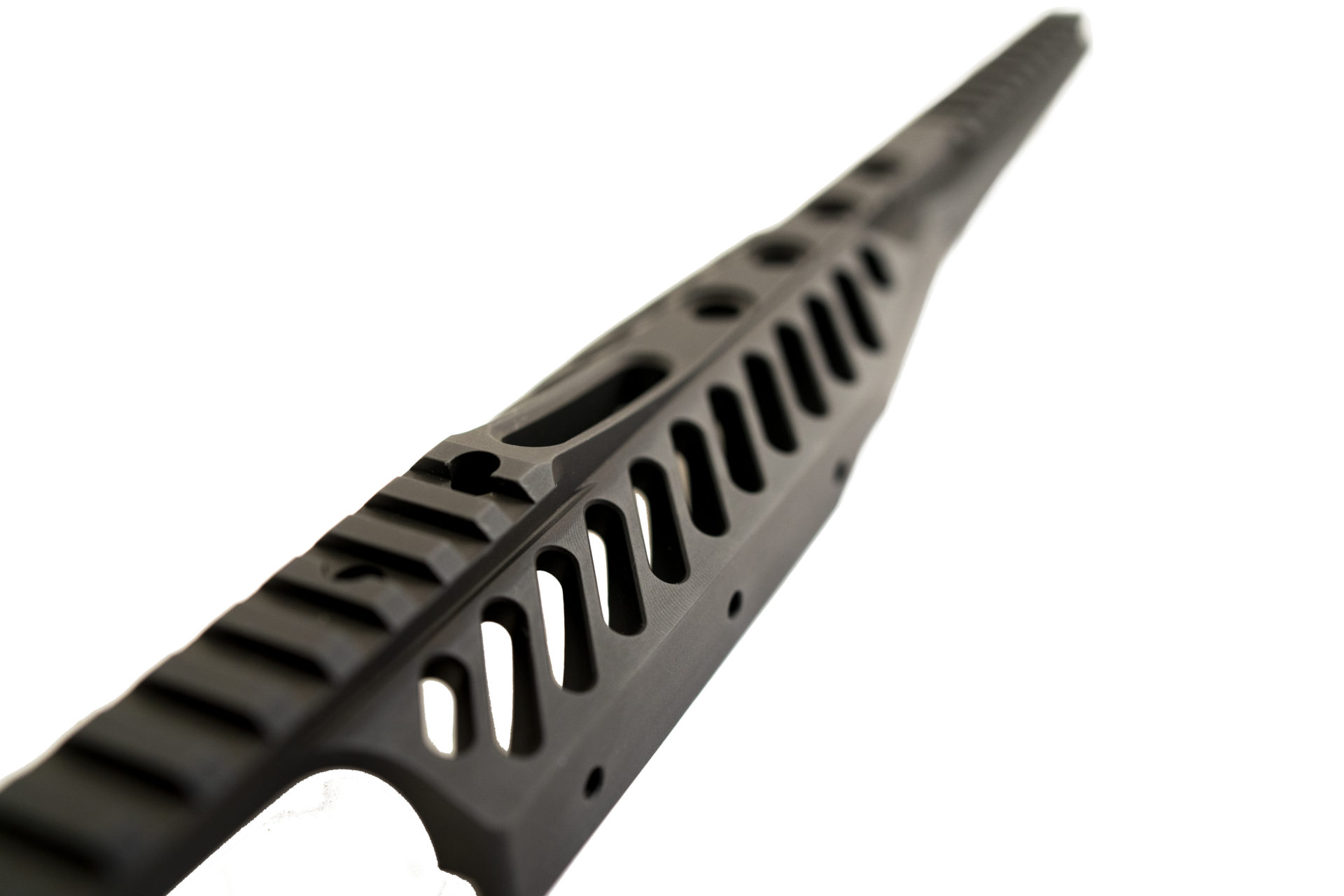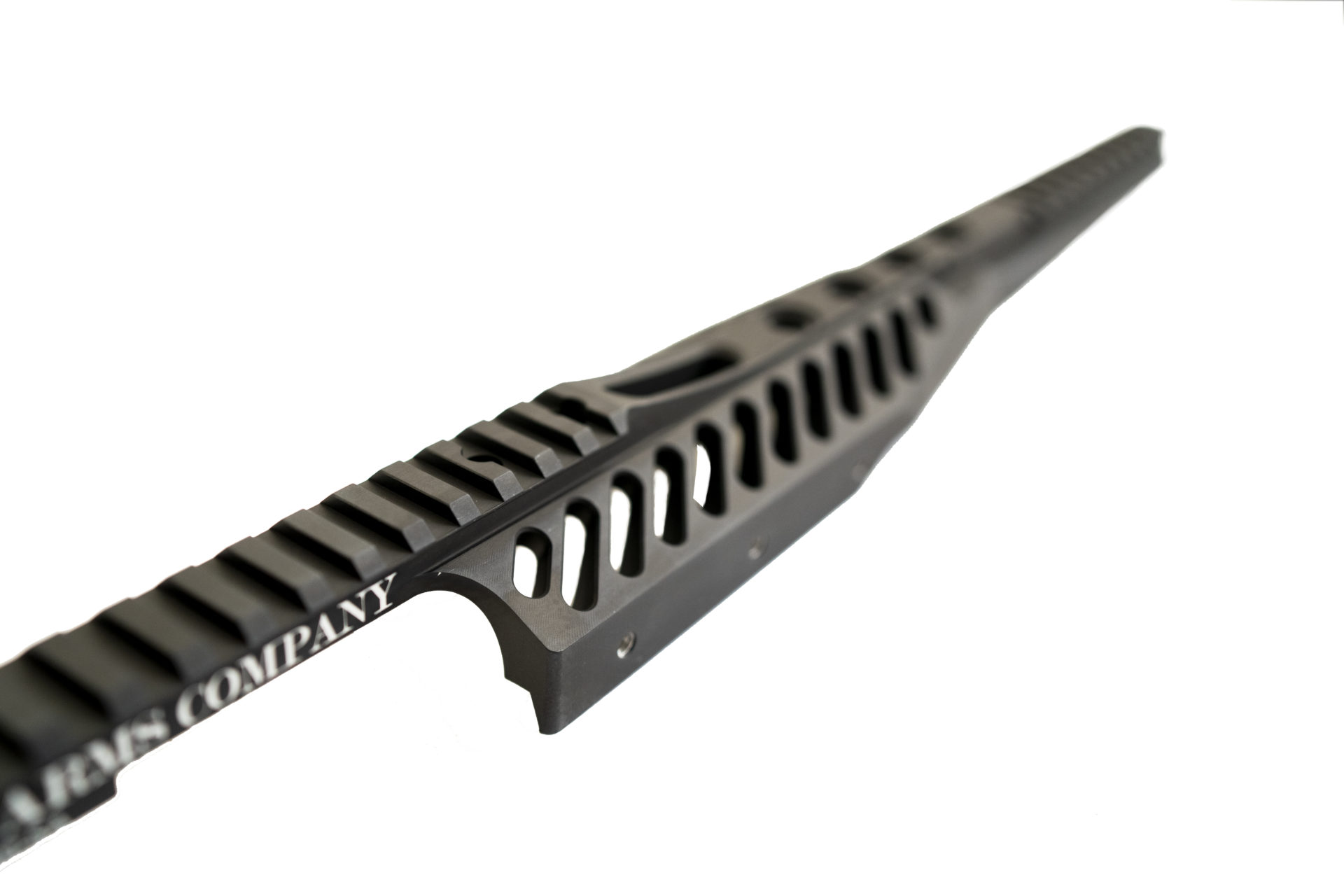Modern firearm accessories like scopes, lights, lasers, IR illuminators, and foregrips almost exclusively use a Picatinny rail to attach to your gun, but why is that?
What has made Picatinny rails the defacto standard across the industry? Why are they so popular? And what separates a good Pic rail from a bad one?
Let’s take a deep dive into the world of the Picatinny rail and answer all these questions. We’ll talk about where this rail system came from, why it’s so widely used, and how to choose a good, high-quality one for your next rifle build or for when you need to slap a new light on your gun.
What Exactly is a Picatinny Rail?

Picatinny rail, also called just Pic rail and known as the MIL-STD 1913 rail, is a system for connecting accessories to a firearm or other railed piece of equipment. This is the rail that you see on most Western military rifles, and it has since become a standard almost across the entire industry on all types of firearms, especially for optics.
It was originally developed as a way to standardize earlier Weaver-style rails which were similar in design but not completely the same across manufacturers. This caused a great deal of trouble with accessory manufacturers, especially following Operation Desert Storm when the US was suddenly putting lights, grips, and IR lasers/illuminators on infantry weapons.
In February of 1995, the modern Picatinny rail was approved and fielded for the first time. Design was headed up by Picatinny Arsenal (hence the name) and the rest, as they say, is history.
The approved rail used a series of raised hexagonal sections that are separated by slots that run across the rail. This allows an accessory to be slipped on over the hexagonal section and then locked into place with bolts or levers that fit into the perpendicular slots
The final design also uses the same general shape as the older Weaver rail, but the rail is a bit taller and has wider slots. This allows it to accommodate many older Weaver-compatible accessories, though most Weaver rails won’t play nicely with modern Picatinny-compatible accessories.
Today, just about every accessory from optics to foregrips uses the Picatinny rail system. Picatinny rail handstops are common on many modern military firearms, and you can even get 1913 pic rail stocks for certain firearms.
Newer M-Lok direct attachment systems are becoming popular too, but Picatinny is still used for almost every top rail on every modern firearm that has one.
Most accessories like lights and lasers are still made for Picatinny rails as well, so even with an M-Lok handguard, most shooters add M-Lok-compatible sections of Pic rail to the handguard where needed and then attach the accessory that way.
Picatinny rail mounts for accessories like lights, lasers, and IR illuminators will likely stay popular for decades as the US military and NATO continue to use the system. Today, most of these accessories are designed with attachment to a Pic rail in mind.
Advantages of Picatinny Rail

There are three main advantages to the Picatinny rail system: standardization, versatility, and durability/strength. Let’s take a look at each of these individually to find out what really has made Picatinny rail so popular.
Standardization
The official Picatinny rail standard is for a locking slot width of .206”, a slot center spacing of .394”, and a slot depth of .118”. This standard was originally applied to optics rails on the top of firearm receivers, and was then expanded to include everything from rifle foregrips to helmet-mounted lights.
This standardization has had a profound impact on the firearms industry that can still be felt today almost 30 years later.
First and foremost, the fact that the US military adopted the Picatinny rail as a standard across all their weapon platforms led directly to the widespread adoption that followed.
The fact that NATO then picked up the Picatinny rail and upgraded it to the metric-based STANAG 4694 rail has only helped to cement it as the go-to rail system for all Western militaries. From there, the standard has been picked up by many other manufacturers around the globe.
Today, most firearms with any kind of tactical or precision shooting purpose whatsoever come from the factory with Picatinny rails on top. AR-15’s and other sporting rifles, as well as their fully-automatic military counterparts almost always have additional rails as well, or at least a way to add them.
Versatility
The benefit to the average shooter is that you can get Picatinny rail accessories around the world, and you can find just about every accessory you can imagine in a Picatinny-compatible format.
If you have Picatinny rails on your firearm, or the ability to attach them with something like an M-Lok or Keymod system, then you can mount pretty much anything you want on your gun, from flashlight to, we kid you not, a coffee mug.
More practically, it means you can quickly attach a new light, laser, optic, or foregrip, and just as quickly remove it as your needs evolve and you come across a situation that requires a different setup.
This is great for the military because it allows infantry to reconfigure their firearm to suit the mission at hand.
It’s also great for the Joe and Jane Civilian because we can have one rifle that meets a variety of needs, from competition to hunting to home defense.
This kind of operational versatility is a big part of why the US military wanted to standardize their rail systems in the first place.
When military shooters where placed in a situation where they could need a daytime optic at the start of a mission, and need to add night vision and an IR illuminator at the end, the need for a system that could be reconfigured quickly became apparent.
Picatinny rails solved this issue.
For the average shooter, this versatility means that we can configure our firearms quickly and easily, without any special tools or difficult disassembly processes. All most picatinny rail attachments require for removal is to simply turn a bolt or screw and then the accessory slides right off.
It also means that we can swap optics around without losing a zero (most of the time) and we can build out our guns to handle one task, and then swap things around to a different configuration to go do something else.
Durability & Strength
Finally, the nature of the mechanical connection you get from Pic rails is incredibly strong and, just as importantly, repeatable.
The strength of the connection means that you won’t have to worry about something coming loose due to impact (within reason) or torsion (again, within reason) and you won’t have to worry about the connection wearing out over time.
The repeatability of the connection is also very important, especially when it comes to any kind of aiming device, be it an optic or laser. With other, earlier rail systems you pretty much always had to rezero your optic whenever you removed it and reattached it.
With modern Picatinny rails and the machining precision available to us these days, at least from reputable manufacturers, your optic will almost always return to zero just fine as long as it goes back into the same Picatinny slots.
There’s a lot of debate about whether you want aluminum or steel Picatinny rails, but at the end of the day it mostly comes down to user preference. Aluminum is lighter and more corrosion resistant, but steel is a little more wear resistant.
At the end of the day, we typically recommend the former as high-strength aluminum is nearly as strong as steel, and can even exceed the strength of some steels, and is about 2.5x lighter to boot.
Whether you go with aluminum or steel Pic rails, you can rest assured that your optic or laser will have an accurate and repeatable connection, and your lights, foregrips, and stocks will have a strong and durable one.
U.S. Arms Picatinny Rails: The Advantage of Experience
U.S. Arms manufacturers Picatinny rails designed specifically to fit the Remington 700 short action and long action receivers. Our rails are specifically designed to allow for larger optics such as night vision and thermal modules, as well as standard daylight optics.
Our rails are designed to meet the ever-changing needs of military and law enforcement sharpshooters, as well as to give civilian shooters an edge whether they’re on the hunt or on the field of competition.
If you have a Remington 700 rifle (in a short or long action variety) and you want a solid, repeatable way to mount your optics, then a U.S. Arms one-piece Picatinny rail is the way to go in our opinion.
Our rails are made of lightweight, high-strength aluminum and anodized to prevent any kind of damage and corrosion. Come see the difference that advanced engineering and high-precision, end-to-end manufacturing can make for your shooting experience today.
